

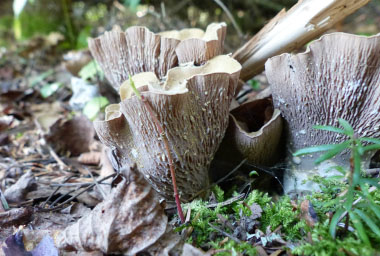
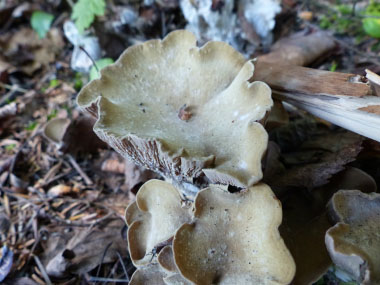

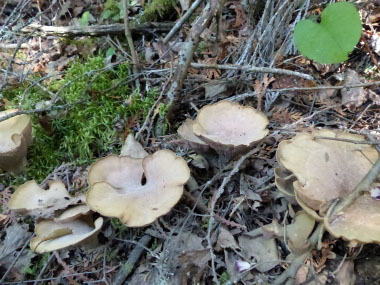
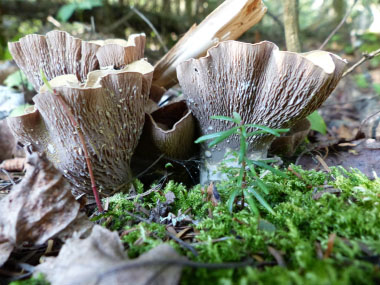
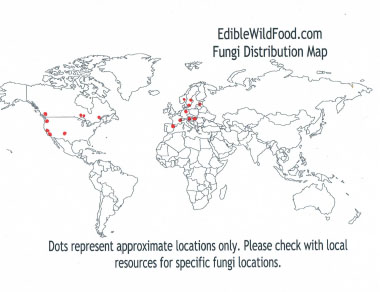
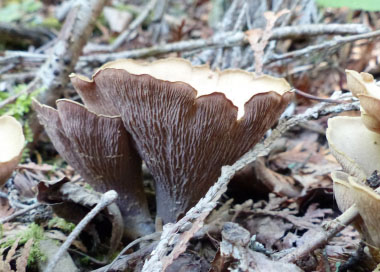
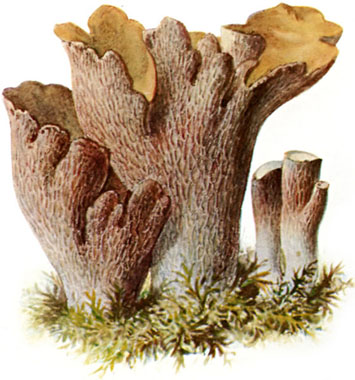
Do not eat any fungi that has not been properly identified by a qualified professional, some are DEADLY when ingested. All edible wild fungi MUST be cooked.
Pig's ear fungi has a mycorrhizal relationship with mainly coniferous trees such as fir and spruce but also with some deciduous trees such as beech trees. The hyphae of the fungus are closely associated with the roots of the tree and both species gain from this relationship. Gomphus clavatus is in the Cantharellaceae family. Extracts prepared from Gomphus clavatus fruit bodies have a high antioxidant activity, and a high concentration of phenolic and flavonoid compounds. Phenolic compounds identified from the fungus include protocatechuic acid, gallic acid, gentisic acid, vanillic acid, syringic acid, cinnamic acid, caffeic acid, ferulic acid, and tannic acid.
Type
Distinguishing Features
Pig's ear fungus derives its name from the funnel-shaped and folded fruiting body, which resembles a pig's ear in shape and texture. The cap is depressed and has a wavy margin; it is violet, fading to yellowish-brown over time. It can be somewhat olive-coloured with age. The stipe (stem) is short and thick and completely solid. The flesh inside the cap and stipe is white. The underside of this mushroom does not have true gills, it has ridges that run down the stalk almost entirely to the base.
Height
This mushroom grows up to 15cm (6”) tall. They measure 5 to 10cm (2 to 4”) across at the top.
Habitat
Pig's ears grow in coniferous forests (especially among spruces and firs). They grow from the mossy ground or on rotten wood. They are usually found in large clusters, arcs, or rings and can yield very high quantities. They are more common at elevations of greater than 600 metres (2,000') in moist, shady areas with plenty of leaf litter.
Spore Print
Spore print is ochre (brownish).
Season
The lobed fruiting bodies appear between August and November.
Gills
Gills are decurrent, poorly developed consisting of shallow wrinkles. They are pale purply-brown.
Edibility
Pig's ears are truly exceptional mushrooms. They have a very firm and meaty texture, which holds up well in soups, sauces, and baked dishes. They have a great musty and earthy aroma and taste really nice. As all wild fungi, they must be cooked.
Other Name
Violet chanterelle..
Recipes
To support our efforts please browse our store (books with medicinal info, etc.).
Winter Survival Food Handbook

PDF Plant Magazines
Types of Wild Food
Geographic Zones Seasons
Disclaimer
EdibleWildFood.com is informational in nature. While we strive to be 100% accurate, it is solely up to the reader to ensure proper plant identification. Some wild plants are poisonous or can have serious adverse health effects.
We are not health professionals, medical doctors, nor are we nutritionists. It is up to the reader to verify nutritional information and health benefits with qualified professionals for all edible plants listed in this web site. Please click here for more information.
Why Edible Wild Food?
- Food costs are rising
- Free, wild food is readily abundant
- Wild food adds nutrition to your diet
- Wild food can help treat various medical conditions





